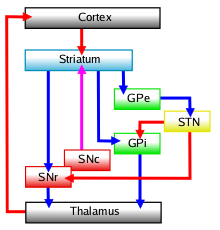Structural Biochemistry/Basal Ganglia
Basal Ganglia is a group of nuclei lying deep in the subcortical white matter of the frontal lobes that organize motor behavior. The caudate, putamen, and globus pallidus are major components of the basal ganglia. Basal ganglia appears to serve as gating mechanism of physical movements, inhibiting potential movements until they are fully appropriate for the circumstances in which they are to be executed.
-
Caption1
-
Caption2
Direct and Indirect Pathway
[edit | edit source]The net effect of basal ganglia activation through this so-called direct pathway is thus excitiation of cortical neurons. The subthalamic nucleus, on the other hand, forms part of an internal loop within the basal ganglia that via excitation of a portion of the globus pallidus has a net inhibitory effect on the cortical neurons, so called indirect pathway. The balance of excitatotry and inhibibory effects of the basal ganglia releases and coordinates desired movements.

It is speculated that when a voluntary movement is about to be initiated by cortical mechanisms, the direct pathway selectively facilitates certain motor programs in the cerebral cortex that are adaptive for the present task and the indirect pathway simultaneously inhibits the execution of competing motor programs.
Basal Ganglia Functions
[edit | edit source]1. Rule-based habit learning system - initiating, stopping, monitoring, temporal sequencing, and maintaining the appropriate movement 2. Braking Function - inhibiting undesired movements and permitting desired ones 3. Action Selection - choosing from the potential actions, cortex plans to perform the ones that actually get executed 4. Other cognitive role - Motor planning, sequencing, learning, maintenance, predictive control, working memoery, attention, switches in behavioral set.
Relation to Parksinson's disease
[edit | edit source]In parkinson's disease, the selective death of neurons in the substantia nigra pars compacta that use the neurotransmitter dopamine increases the excitatotry tone of the direct pathway through basal ganglia. Patients with Parkinson's show a marked disruption in the ability to initiate voluntary movement. This decrease excitation in direct pathway which increase inhibition in indirect pathway, thus resulting more inhibition of thalamaus and less excitotry input to motor cortex.
References
[edit | edit source]Purves, Dale, "Principles of Cognitive Neuroscience", Sinauer Associates, Inc., 2008
Levinthal, Charles, "Drugs, Behavior, and Modern Society", Pearson Education, Inc., 2008

